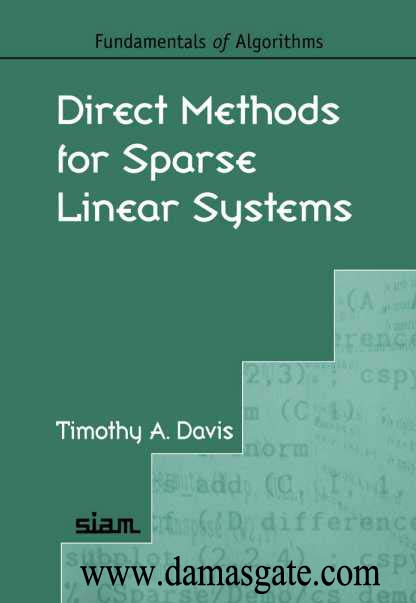Direct Methods for Sparse Linear Systems

Preface
This book presents the fundamentals of sparse matrix algorithms, from theory
to algorithms and data structures to working code. The focus is on direct methods
for solving systems of linear equations; iterative methods and solvers for eigenvalue
problems are beyond the scope of this book.
The goal is to impart a working knowledge of the underlying theory and prac-
tice of sparse matrix algorithms, so that you will have the foundation to understand
more complex (but faster) algorithms. Methods that operate on dense submatrices
of a larger sparse matrix (multifrontal and supernodal methods) are much faster, but
a complete sparse matrix package based on these methods can be tens of thousands
of lines long. The sparse LU, Cholesky, and QR factorization codes in MATLAB®,
for example, total about 100,000 lines of code. Trying to understand the sparse
matrix technique by starting with such huge codes is a daunting task. To overcome
this obstacle, a sparse matrix package, CSparse,1 has been written specifically for
this book.2 It can solve Ax = b when A is unsymmetric, symmetric positive definite,
or rectangular, using about 2,200 lines of code. Although simple and concise,
it is based on recently developed methods and theory. All of CSparse is printed in
this book. Take your time to read and understand these codes; do not gloss over
them. You will find them much easier to comprehend and learn from than their larger
(yet faster) cousins. The larger packages you may use in practice
are based on much of the theory and some of the algorithms presented more concisely and
simply in CSparse. For example, the MATLAB statement x=Ab relies on the theory
and algorithms from almost every section of this book. Parallel
sparse matrix algorithms are excluded, yet they too rely on the theory discussed here.
For the computational scientist with a problem to solve using sparse matrix
methods, these larger packages may be faster, but you need to understand how
they work to use them effectively. They might not have every function needed to
interface them into your application. You may need to write some code of your own
to manipulate your matrix prior to or after using a large sparse matrix package.
One of the goals of this book is to equip you for these tasks. The same question
applies to MATLAB. You might ask, "What is the most efficient way of solving
my sparse matrix problem in MATLAB?" The short answer is to always operate on
whole matrices, large submatrices, or column vectors in MATLAB and to not rely
Download
*